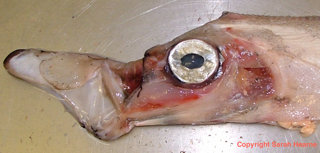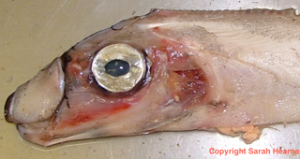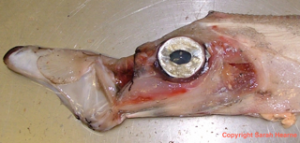Below the thunders of the upper deep,
Far far beneath in the abysmal sea . . .
[Tennyson, The Kraken]
Strange things are stirring from the deep. Creatures from myths and legends, the sea serpents of old, are descending upon our shores to warn us of impending doom. . .
Well, maybe not. But the news that not one but two mysterious oarfish have been found dead and beached in California recently has spread around the world, reminding people that the oceans still harbour creatures that are stranger and more alien to us than even the most hallucinogen-induced science fiction creations.
Oarfish are members of the genus Regalecus. There are three species, R. glesne, R. kinoi, and R. russelii, found in the Atlantic, Eastern-Central Pacific and Indo-Pacific respectively. They are the largest bony fish in the world and can reach over 11m in length. Very little is known about them. Unfortunately most of the published literature concerns their meristics which are important but make for incredibly dull reading.
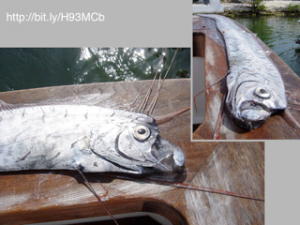
Regalecus is one of two genera in the family family Regalecidae. The other genus, Agrostichyhtys, is monospecific and contains the species A. parkeri, commonly known as the ribbonfish or streamerfish. A. parkeri is even less well-known than the oarfish. Wikipedia says that it is known from only seven specimens, though I know this is an underestimate as I have personally seen and dissected two that are not included in that list and I’m sure there are more in museum and fisheries department basements around the world that just haven’t made it into the literature.
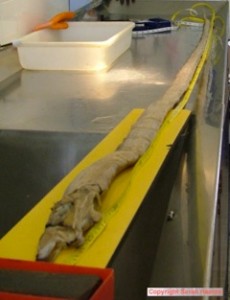
There are a number of reasons the Regalecids are so poorly known. They live in the open ocean and if caught at all it is usually as part of a commercial catch where scientific research is low down the list of priorities. Their delicate shape also means that they damage easily and often what is hauled on board is barely recognisable as fish, let along as a Regalecid.
Another reason is that they elude scientific surveys as they are perfectly camouflaged and are almost impossible to see. I know this may sound crazy – an 11m long shiny silver animal with a gigantic eye surely can’t be hiding, it’d be like dressing up as a mirror-ball and expect to be able to blend into the background. But actually, that’s precisely what they are doing.
Their morphology has evolved for a very specific environment: the mesopelagic zone. This zone, colloquially termed the ‘twilight zone’, is the transitional part of the ocean, where light is still visible when you look up but there is nothing but blackness when you look below. A fish that is swimming in the water column will be seen as a black silhouette against the light when viewed from below or will stand out against the black of the deep when viewed from above.
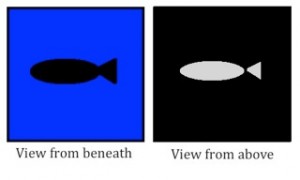 This makes mesopelagic fish vulnerable to predation so they have evolved a number of countermeasures. The first is to be laterally compressed. This means that there is less of them to block or reflect any light. If you cannot compress laterally then a second option is to countershade – make your belly light and your black dark. Pelagic sharks, fish and even birds do this – it’s why penguins wear tuxedos.
This makes mesopelagic fish vulnerable to predation so they have evolved a number of countermeasures. The first is to be laterally compressed. This means that there is less of them to block or reflect any light. If you cannot compress laterally then a second option is to countershade – make your belly light and your black dark. Pelagic sharks, fish and even birds do this – it’s why penguins wear tuxedos.
Now that attacks from above and below have been dealt with, attacks from the side must next be tackled. For this, light contrast isn’t so much of a problem, but uniformity is as fish present a uniform block of colour against a dappled background. And this is where the silver comes in. The reflective surface of the fish, combined with their undulating body, help break up the light and allow it to merge into the background. If you don’t believe me watch this video of an oarfish in its natural habitat.
These adaptations mean they are able to successfully hide from all but the luckiest of predators. Yet life is more than just about avoiding being eaten. It’s also about finding food. This is incredibly difficult in the sparsely populated open oceans. and it is here that the giant eyes come in. Unlike the bathypelagic zone where eyesight is largely redundant, here in the mesopelagic zone there is just enough light to see by. You’ll notice the large pupil which has evolved to catch every last photon of light in order to detect potential prey, who, it’s worth pointing out, have evolved the same anti-predation adaptations as the Regalecids. If you watch the video you’ll see that oarfish sit vertically in the water column, looking up towards the ocean surface so they can fully exploit their excellent vision and spot anything passing overhead. Prey are few and far between, and are constantly on guard against being eaten. To catch anything stealth and speed are essential. And this is where their weirdest adaptation comes into play.
Before I continue, I want to point out that what follows is pure speculation as I can find nothing in the literature that discusses this, the most bizarre aspect of Regalecid morphology. I thought it was unique to A. parkeri but closer inspection of photos and videos (this is R. russelii) indicates this is a feature common to the family. I am talking about their mouth.
At rest there is little of note.
It’s a bit strange in appearance, almost beak-like, but fish have evolved all sorts of weird appearances. Nothing to worry about, maybe.
Think again.
The ‘beak’ extends! It forms a sort of funnel and we (my former colleagues and I) speculated that this might be to try and change the water pressure to help suck prey in. The narrow tube quickly opens up into the wider ‘pouch’ towards the back. This suggests there will be rapid changes in water pressure but without proper study, and live observations, this is all complete conjecture which is crying out for research.
As if all that isn’t enough to pique your interest, there are reports that the live fish give electric shocks:
“Jason McKenzie reported that when he picked up the fish . . . he experienced what he described as mild but quite distinct pulsed electric shocks that passed up through his hand into the forearm at intervals of about 10 s. A companion who independently held the fish reported the same sensation.”1
There is nothing coherent I can say about that; it just blows my mind!
It’s a real shame the media frenzy has been so superficial. There is so little known about these animals: basic biology such as how long they live, how often they reproduce, how they find mates, what they eat and what eats them is all unknown. These new specimens will undoubtedly be studied exhaustively. The media hype will have died down by the time the results are published, but I recommend keeping an eye out as they will add so much more to the understanding of these magnificent, elusive animals.
1 McDowall, R M & Stewart, A L (1999). Further specimens of Agrostichthys Parkeri (Teleostei: Regalecidae), with natural history notes. Proceedings of the 5th Indo-Pacific Fish Conference, Noumea, 1997. pp165-174. Séret, B & Sire, J-Y, eds. Sociéte Française d’Ichthyologie, 1999, Paris.
Author and Picture Credits: Sarah Hearne, hearnes[at]tcd.ie, @SarahVHearne

